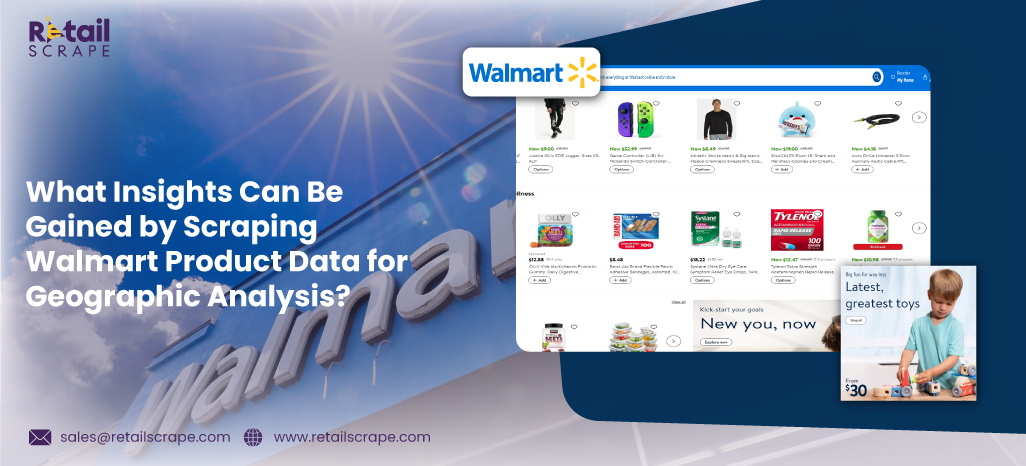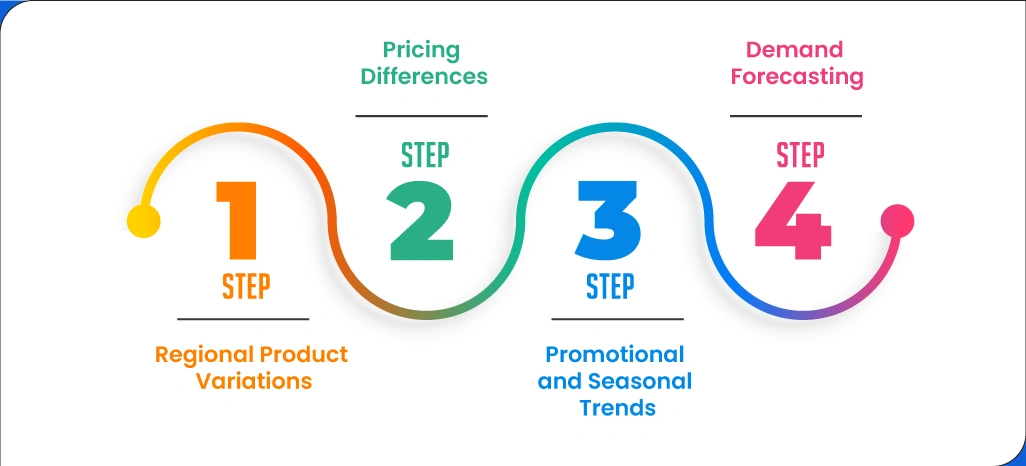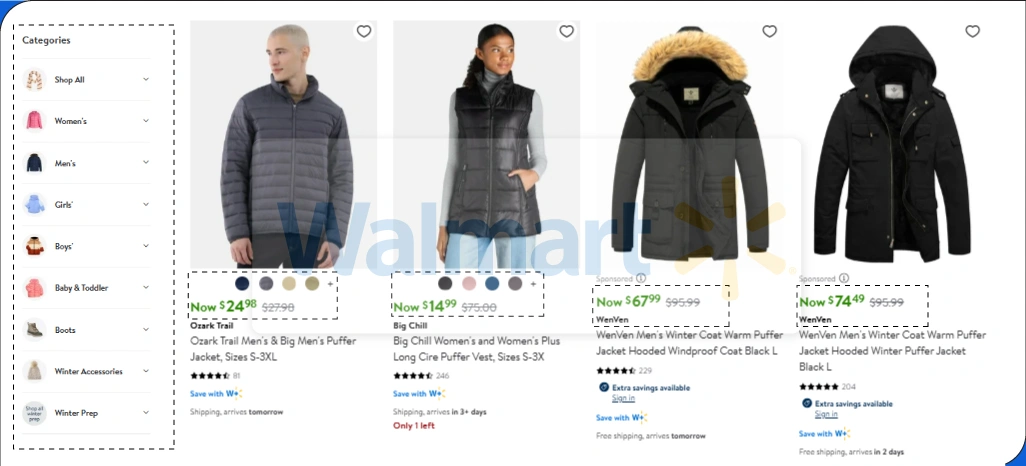What Insights Can Be Gained by Scraping Walmart Product Data for Geographic Analysis?

Introduction
A global retail giant, Walmart operates with a vast product catalog and extensive geographical presence. With over 10,000 stores worldwide and a strong online footprint, Walmart dominates the retail industry. The company's strategic decisions shape various factors, including location- based dynamics, consumer preferences, and regional market conditions. In this article, we delve into how scraping Walmart product data can uncover valuable insights into the company's geographic strategy. By analyzing product availability, pricing models, and promotional activities across different regions, businesses can better understand how Walmart tailors its offerings to local markets. Extract Walmart products with BeautifulSoup to collect large volumes of product data, enabling businesses to track regional trends and forecast demand. This data helps identify regional variations in product assortment, pricing strategies, and localized promotions, allowing companies to make informed decisions and optimize their operations in a competitive retail environment.
The Role of Geographic Analysis in Walmart's Strategy

Geographic analysis refers to examining data by location to uncover patterns and trends that can influence business decisions. This analysis is critical for a retail giant like Walmart as it allows the company to adapt its strategies according to varying regional preferences, economic conditions, and competitive environments. Whether determining the types of products to stock in stores, understanding regional demand variations, or setting appropriate pricing models, geographic analysis is vital in ensuring Walmart remains competitive in each market segment. Walmart's geographic strategy is influenced by external factors, such as the local economic climate, and internal factors, such as its supply chain capabilities and product assortment. By analyzing product data from different regions, Walmart can optimize its operations and meet local consumer demand while maintaining cost efficiency. Retail data analysis is crucial in this process, helping Walmart fine-tune its operations to match regional preferences. Data analytics in the retail industry is essential for identifying trends, improving product offerings, and refining strategies that ensure success in competitive markets.
How Geographic Insights Are Extracted from Walmart?

Data scraping refers to collecting large volumes of data from websites using automated tools or scripts. For Walmart, this could involve scraping data from its online product catalog, including product details, pricing, availability, and location-specific offerings. Businesses can gain insights into regional market trends, customer preferences, and localized product demand by analyzing this data.
Key insights that can be extracted from Walmart product data include:
1. Regional Product Variations: Walmart's product catalog often varies by region, with certain products being more prevalent in specific areas due to cultural, seasonal, or economic factors. Scraping Walmart product data from various regions allows analysts to track which products are more frequently available or promoted in each geographic area. This geographic insight helps Walmart tailor its offerings based on regional preferences.
2. Pricing Differences: Walmart's pricing strategy is often adjusted based on geographic factors, such as local competition, supply chain costs, and regional income levels. By scraping pricing data from different regions, it is possible to identify price variations and understand how Walmart's geographic strategy adapts its pricing to optimize sales in each market. This allows Walmart to remain competitive across diverse regions.
3. Promotional and Seasonal Trends: Walmart frequently runs region-specific promotions or discounts that cater to local preferences or seasonal events. Data scraping can help track these promotions and determine how they differ by location, revealing insights into the company's regional marketing strategies. Walmart store mapping can further enhance this analysis to visualize how promotions align with store locations.
4. Demand Forecasting: Scraping allows businesses to forecast demand more accurately by collecting data on sales trends, product demand, and customer reviews across different regions. This geographic insight helps Walmart tailor its inventory to meet local needs and avoid overstocking products. Using Google Map Walmart, businesses can map trends and ensure inventory strategies align with regional demand.
Geographic Insights and Product Assortment Optimization

Walmart's product assortment is tailored to each region to cater to local preferences and consumer behavior. Data scraping can provide insights into how Walmart adapts its product offerings across different locations. These insights are valuable for understanding regional product preferences, which can help improve inventory management and ensure that the right products are available in the right locations.
For example, a Walmart store in a coastal area might stock more beach-related products, such as sunscreen, swimsuits, and outdoor equipment. In contrast, a store in a colder, mountainous region might focus on winter gear like jackets, boots, and snow gear. By scraping product data from Walmart's regional catalogs, analysts can gain insights into how the retailer adjusts its offerings based on local consumer needs.
A comparison of product assortment by region can also help Walmart optimize supply chains. By analyzing product availability and demand across different areas, the company can determine which products should be prioritized for distribution to specific regions, reducing transportation costs and improving product availability.
Geographic Pricing Strategies: Decoding the Regional Pricing Model
Walmart's pricing strategy is critical to its competitive positioning. The company uses a combination of everyday low pricing (EDLP) and localized pricing to remain competitive in various geographic areas. Pricing variations occur based on local market conditions, competition, and consumer purchasing power. Scraping Walmart's product data by region allows analysts to uncover pricing patterns and better understand Walmart's regional pricing strategy.
For instance, in metropolitan areas with higher living costs, Walmart may adjust its pricing to reflect the local economic conditions. In contrast, the company may implement lower prices in rural or suburban areas to attract budget-conscious consumers. These pricing models can be analyzed by scraping Walmart's online data, which often reflects the pricing structure in different geographic locations.
A key factor in pricing variation is competition. Walmart closely monitors the prices of its competitors in each region and adjusts its pricing accordingly. Scraping competitor data alongside Walmart's can reveal how Walmart's pricing compares to that of local competitors and highlight strategic adjustments to maintain market share.
Table 1: Walmart Product Pricing by Region
| Product Category | Urban Area Price | Suburban Area Price | Rural Area Price |
|---|---|---|---|
| Electronics | $299 | $279 | $269 |
| Groceries (Cereal) | $3.99 | $3.49 | $3.29 |
| Apparel (Jeans) | $49.99 | $44.99 | $39.99 |
| Home Goods (Vacuum) | $89.99 | $79.99 | $69.99 |
This table illustrates how Walmart adjusts its prices for different product categories based on the region. The retailer’s pricing strategy reflects its understanding of consumer preferences and purchasing power in each geographic area.
Using Scraping to Identify Regional Demand and Supply Trends
Scraping Walmart product data across different regions provides insights into regional demand trends, allowing businesses to understand which products are in high demand and underperforming. By analyzing product data from different regions, businesses can better predict product shortages or surpluses and optimize inventory distribution accordingly. For example, during certain times of the year, such as the back-to-school season or holiday shopping periods, demand for specific product categories will surge in certain regions. Scraping data on product availability and customer reviews can help Walmart understand these demand surges and adjust its supply chain to meet customer needs promptly.
Additionally, geographic analysis of supply chain data can highlight inefficiencies or opportunities for improvement. If data scraping reveals that certain products are frequently out of stock in specific regions, Walmart can adjust its inventory practices or supplier relationships to ensure better availability.
Table 2: Regional Demand Analysis for Walmart Products
| Product Category | High Demand Region | Medium Demand Region | Low Demand Region |
|---|---|---|---|
| Electronics | Urban Areas (Metros) | Suburban Areas | Rural Areas |
| Groceries (Cereal) | Suburban Areas | Urban Areas | Rural Areas |
| Apparel (Jeans) | Suburban Areas | Urban Areas | Rural Areas |
| Home Goods (Vacuum) | Urban Areas | Suburban Areas | Rural Areas |
This table demonstrates the variations in demand for different products across regions. For example, electronics see higher demand in urban areas, where consumers have greater purchasing power and access to advanced technology, while groceries like cereal perform better in suburban areas.
The Impact of Localized Promotions and Seasonal Events

Walmart tailors its promotional strategies to the needs and preferences of local customers. By scraping data on promotions, discounts, and special offers, businesses can gain insights into how Walmart adapts its marketing efforts for different regions. For example, Walmart might offer region-specific discounts or product bundles during a local festival or holiday season. Scraping such data allows analysts to identify trends in promotional activities and regional sales performance.
Moreover, seasonal events and holidays significantly shape Walmart’s product offerings and pricing strategies. For example, during the winter, Walmart may offer discounts on heaters, warm clothing, and holiday decorations in colder regions. In contrast, air conditioners, outdoor furniture, and pool accessories may be promoted in warmer areas.
Conclusion
Scraping Walmart product data is invaluable for decoding the company’s geographic strategy. By collecting and analyzing data from various regions, businesses can gain critical insights into Walmart’s product offerings, pricing strategies, and promotional tactics. Geographic analysis through data scraping allows for a better understanding of consumer behavior, demand patterns, and regional preferences, enabling businesses to optimize their own operations and marketing strategies. Utilizing Walmart's Black Friday map can enhance this analysis, providing a clearer picture of seasonal variations and promotions tied to specific locations.
As Walmart continues to evolve its operations, geographic analysis through Walmart data scraping will remain an essential tool for maintaining competitive advantage. With the correct data, businesses can enhance their product assortment, pricing models, and promotional strategies to meet the diverse needs of consumers in various regions. Ultimately, web scraping Walmart product data bridges data and decision-making, allowing businesses to make informed, data-driven choices in an ever-changing retail landscape.
Transform your retail operations with Retail Scrape Company’s data-driven solutions. Harness real-time data scraping to understand consumer behavior, fine-tune pricing strategies, and outpace competitors. Our services offer comprehensive pricing optimization and strategic decision support. Elevate your business today and unlock maximum profitability. Reach out to us now to revolutionize your retail operations!
